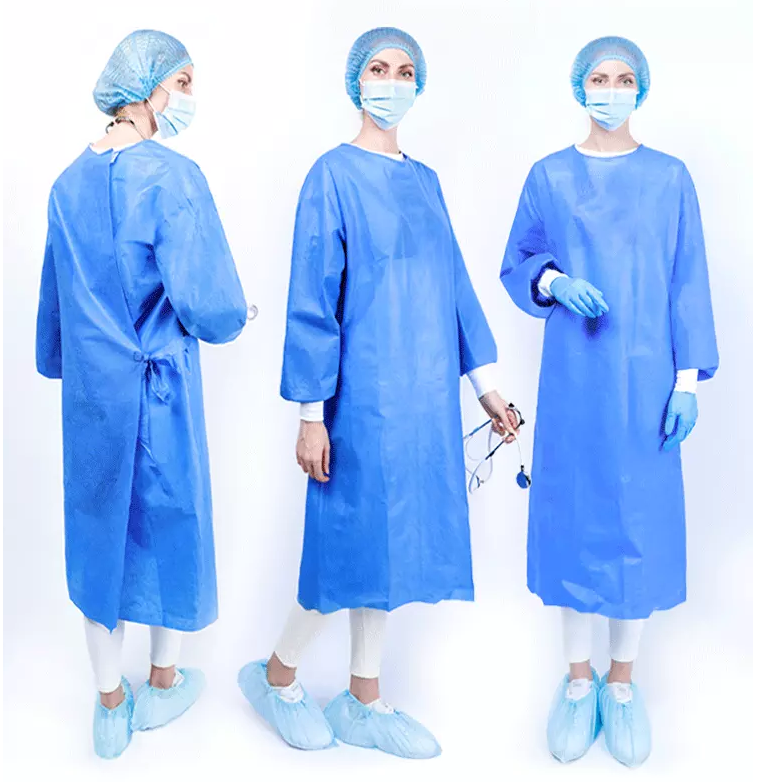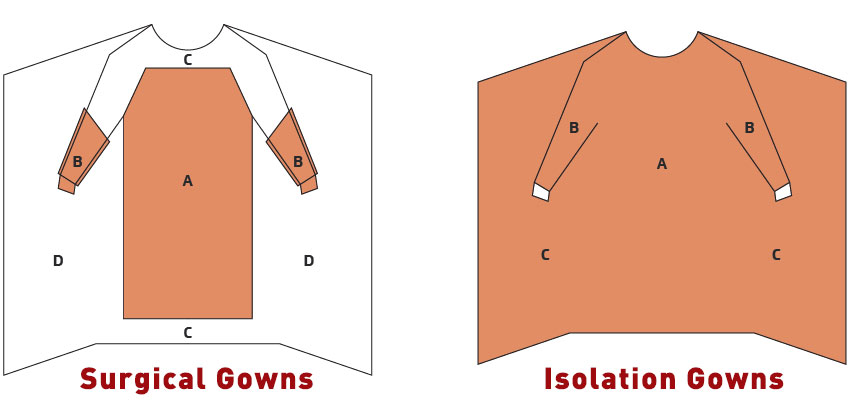What’s the difference between medical disposable gowns and surgical gowns?
As we all know, as the pandemic continues to circulate, human health protection is facing huge challenges. And it has caused the In short supply of many protective products, such as protective masks, protective clothing, disposable gowns, etc. But do you know which disposable gowns on the market meet the epidemic prevention standards? What’s the difference between medical disposable gowns and surgical gowns? Following us, you can find the answers below.
What’s the standard of the surgical gown?
A surgical gown is regulated by the FDA as a Class II medical device that requires a 510(k) premarket notification. A surgical gown is a personal protective garment intended to be worn by health care personnel during surgical procedures to protect both the patient and health care personnel from the transfer of microorganisms, body fluids, and particulate matter.
Because of the controlled nature of surgical procedures, critical zones of protection have been described by national standards. As referenced in Figure 1: the critical zones include the front of the body from the top of shoulders to knees and the arms from the wrist cuff to above the elbow. Surgical gowns can be used for any risk level (Levels 1-4). All surgical gowns must be labeled as surgical gowns.

What Are Isolation Gowns?
Isolation gowns are Personal Protective Equipment (PPE) that cover the torso, arms, and clothing. They act as a liquid barrier against blood, bodily fluids, and other infectious materials.
The gowns serve two purposes: to protect healthcare workers from potential contaminants and to prevent healthcare workers from transferring microorganisms that could harm vulnerable patients.
Isolation gowns are worn during procedures and patient-care activities where the healthcare worker anticipates contact with patient clothing, blood, bodily fluids, secretions, and excretions. The type of isolation gown necessary depends on the nature of the patient interaction and the level of risk present.
You’ll sometimes find isolation gowns referred to as “protective gowns,” “precaution gowns,” and “cover gowns.” But the FDA does not recognize these terms in their classification of medical devices, and many of these do not adequately protect wearers.
For example, cover gowns sometimes refer to isolation gowns with no barrier, but both the AAMI and FDA definitions of isolation gowns are PPE meant to protect healthcare professionals and patients from the transfer of microorganisms and bodily fluids — in other words, they have a barrier.
To be sure that your isolation gown will properly protect you, check that the AAMI standards and levels of protection are appropriate for the task.
What Types of Isolation Gowns Are Available?
According to the FDA, there are two main types of isolation gowns:
- Surgical isolation gowns
- Non-surgical isolation gowns
However, there are also clean and sterile versions of these along with differing levels of barrier protection
- Surgical Gown: Surgical gowns can be used for any risk level (Levels 1-4). A surgical gown is a personal protective garment intended to be worn by health care personnel during surgical procedures to protect both the patient and health care personnel from the transfer of microorganisms, body fluids, and particulate matter. All surgical gowns must be labeled as surgical gowns.
- Surgical Isolation Gowns: Surgical isolation gowns are used when there is a medium to high risk of contamination. A need for larger critical zones than traditional surgical gowns. All areas of the surgical isolation gown except (bindings, cuffs, and hems) are considered critical zones of protection and must need the highest liquid barrier protection level for the gown. All seams must have the same liquid barrier protection as the rest of the gown.
- Non-Surgical Gown: Non-surgical gowns are used to protect the wearer from the transfer of microorganisms and body fluids in low or minimal risk patient isolation situations. When there is a medium to high risk of contamination, non-surgical gowns are not worn during surgical procedures, invasive procedures. Non-surgical gowns are like Surgical isolation gowns.
What’s the Difference Between an Isolation Gown VS Surgical Gown?
The main difference between surgical gowns vs isolation gowns is the designated critical zones of protection.
In surgical gowns, the critical zones include:
- the front of the body from the top of shoulders to knees
- the arms from the wrist cuff to above the elbow
Whereas in isolation gowns, the critical zones of protection are far larger and include almost the entire gown, minus the bindings, cuffs, and hems.
This picture depicts the difference in critical zones:

Are Surgical Gowns Reusable?
Woven surgical gowns are reusable, but with a caveat: the protective properties of the gown tend to fade with repeated wetting or laundering. It’s for this reason that most surgeries these days are performed using disposable surgical gowns or drapes, despite the environmental impact and greater cost over time.
Textile technology and medical knowledge are constantly improving, however. It was only in 1952 that the surgical community realized that cotton muslin became an ineffective barrier once it was wet. But only in 1995 did we finally reach a consensus on standards to evaluate medical apparel.
Just recently, a study evaluating disposable versus reusable medical gowns found that Level 1 and 2 disposable gowns on the market did not meet AAMI specifications for impact penetration water resistance. That means that putting aside the greater costs and carbon footprint, disposable gowns also may not protect healthcare workers as well as reusable ones
This, combined with the shortage of PPE, is partly why the Center for Disease Control (CDC) recommended a shift to “cloth gowns” in March 2020. When laundered according to CDC-recommended wash procedures, the reusable medical gowns retained their protective properties even after 75 washes.
How to choose the right surgical/isolation gown?
There is an overwhelming amount of disposable gown options available on the market, and the vast majority are manufactured outside of China.
As always when purchasing from other nations, it is crucial that you are getting products from a reliable, valid, and quality source. Guarddent has partnered with trusted suppliers that have undergone our stringent risk management process, whereby you can be assured of a successful supply chain with large quantities of gowns available at competitive rates.
Broadly, there are three key considerations to have when purchasing isolation gowns:
Purpose
Who will be wearing the gown? In what setting will they be working?
Answers to those questions determine what type of isolation gowns you need.
Materials
What are isolation gowns made of? Disposable isolation gowns are made from polyethylene or polypropylene. Reusable isolation gowns are made from cotton or synthetic materials like polyester or a poly-cotton blend. They can also be latex-free.
Risk Level
The risk level of the environment and type of exposure anticipated determines what types of isolation gowns you should wear.
For example, in a low-risk environment (like a blood draw), the medical professional needs an AAMI, Level 2 gown.
Where to purchase the medical disposable gowns and surgical gowns?
Companies might advertise different product names when they are selling isolation gowns (e.g., patient gown, nursing gown, procedural gown, non-surgical gown, etc.). You should pay attention to function, intended use, and what level of protection is provided. The packaging and description clearly indicate what level of protection it offers.
With the key factors in selecting an isolation gown, you will be guided accordingly in getting the right one!

Guarddent is a diversified company including researching and development, sales, and manufacturing in China.
The company has devoted itself to medical disposable products and dental disposable products for years with various types and colors to meet clients from all over the world with complete certificates.
The manufacturing base of medical disposable items is located in Xiantao City Hubei Province.
The manufacturing base of dental disposable items is located in Langfang City Hebei Province and Tianjin with approved ISO1348, CE, and FDA certificates which cover 18000m3 all total.
Consistent quality, Customers first, Win-win cooperation have been our goal to move forward, your satisfaction will be the biggest support for us.
